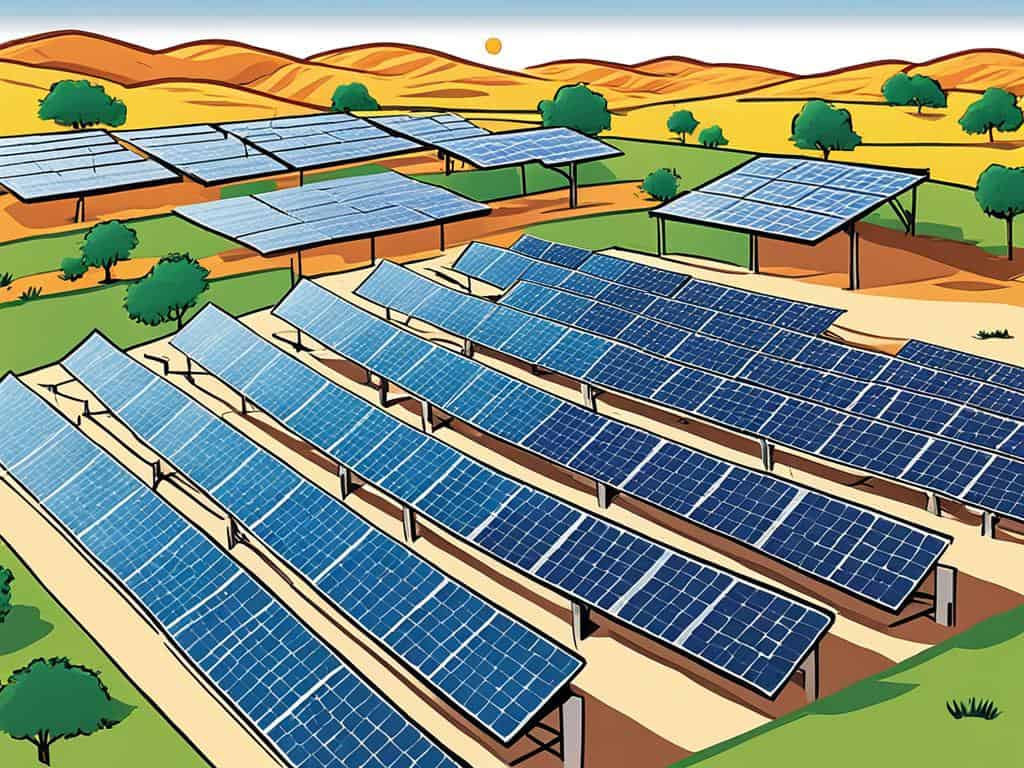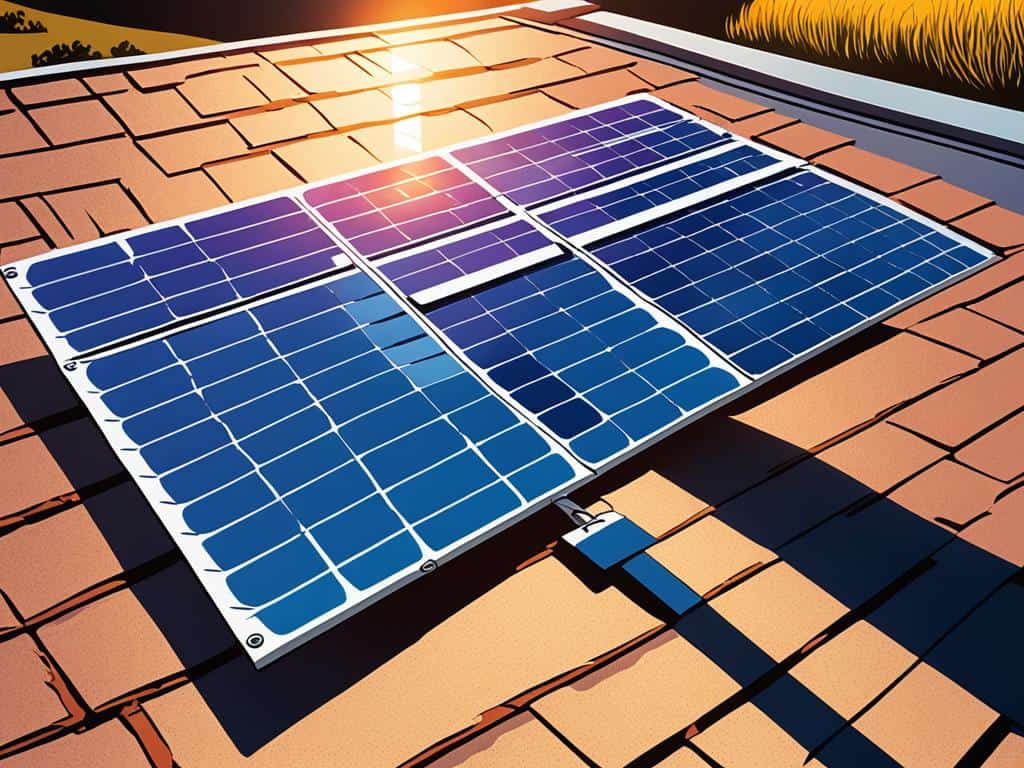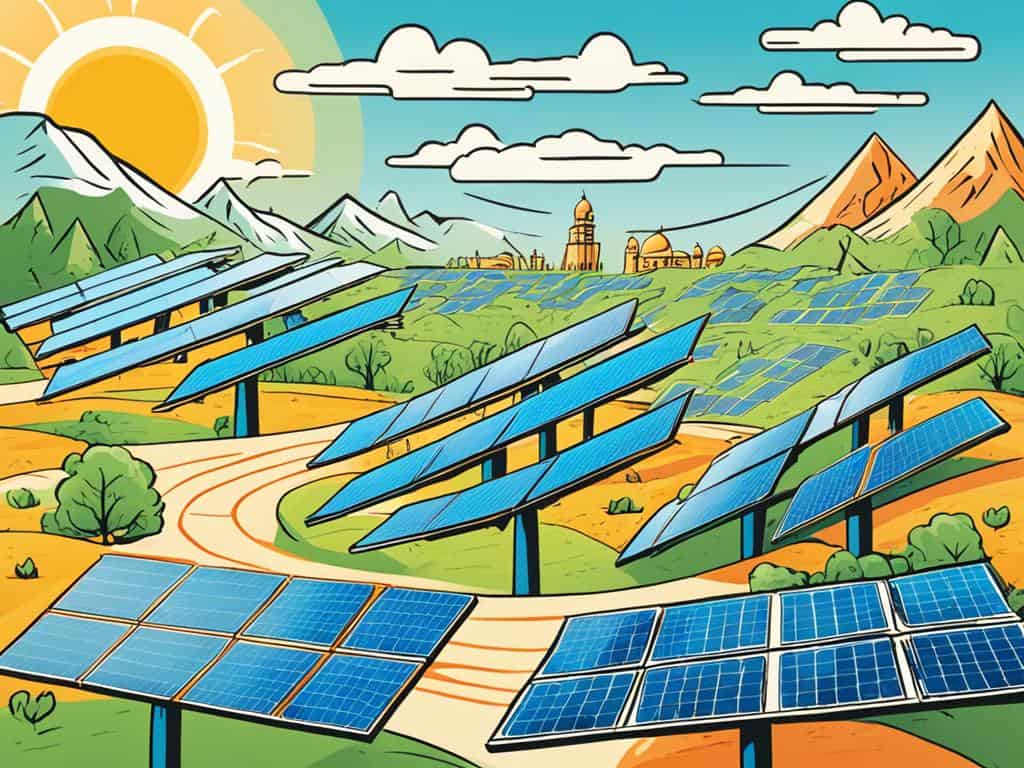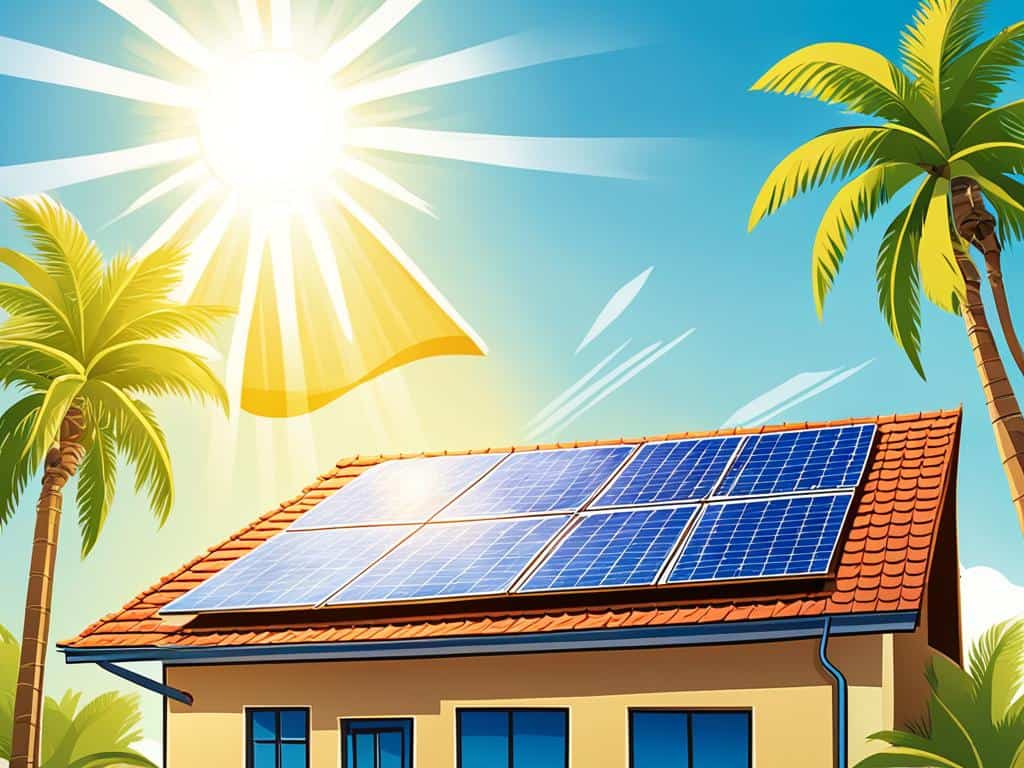Directing Sunshine: Optimizing Solar Panel Orientation for Indian Climates
Unlock the full potential of solar energy in India with expert guidelines on the ideal solar panel direction for maximum efficiency and sustainability.

India is making big moves towards solar energy. This shift makes it key to use advanced solar tech effectively. How solar panels are set up can really boost how much electricity we get from the sun. In the sunny skies of India, setting solar panels right can make solar power much more effective. Fenice Energy uses its 20+ years of experience to help India lead in solar energy.
Getting solar panel orientation right could be a big win for getting more green energy. It’s not enough to just point them to the sky. Where you are, the time of day, weather, and the Earth’s tilt all affect how much sunlight your panels can use. Fenice Energy knows how to place solar panels just right for India’s varied weather, offering smart solutions for better power use and savings.
Key Takeaways
- Importance of solar panel orientation for maximizing solar energy in India.
- The influence of geographic factors and the Earth’s tilt on solar radiation.
- Optimal solar panel placement considering local landscape and weather conditions.
- Benefits of adjustable solar trackers in enhancing energy yield.
- Balancing the costs and benefits of advanced mounting systems.
- Customized solar solutions by Fenice Energy for Indian climates.
Understanding the Sun Path in India for Solar Efficiency
India’s journey towards solar efficiency heavily depends on understanding the sun path. Knowing how to harness solar energy is crucial. It requires deep knowledge of India’s geography and environment, especially for placing solar panels in India. The sun’s path changes from Kashmir in the north to Tamil Nadu in the south. This change is due to geographic latitude and the resulting azimuth angle.
The Impact of Geographic Latitude on Solar Panel Placement
India spans latitudes from 6°N to 36°N. This range affects solar power strength. It’s key for setting up solar panels correctly. The latitude not only decides the panel’s angle but also its adjustment for seasonal solar intensity. Adjusting angles helps to catch the most sunlight all year round.
Solar Panel Azimuth Angle: Tailoring to Indian Longitudes
The solar panel azimuth angle also plays a big role in solar efficiency. Fenice Energy suggests a precise plan focusing on the azimuth angle is crucial. This careful setup ensures panels track the sun’s path well. The perfect azimuth angle catches more direct sunlight and minimizes weather effects.
Seasonal Variation of Solar Intensity Across Indian Regions
Even though the sun follows the same path, seasonal solar intensity differs greatly across India. This affects how much energy solar panels can generate. Solar systems must be fine-tuned for these changes. For example, in winter, Dehradun gets intense sunlight for short periods. Solar panels there need adjusting to make the most of this time.
This complex adjustment of angles and positions is key to successful solar panel setup. Fenice Energy’s solar solutions are designed with these factors in mind. They ensure the solar setups work well with the Indian sun’s movements.

Crucial Factors Influencing Solar Panel Direction in India
Getting solar panels installed right is key to tapping into solar energy fully. This is especially true in India because of its diverse landscapes and weather. Knowing the right direction for solar panels in India is crucial. It helps make solar power systems as effective and efficient as possible.
Adapting to India’s Diverse Climatic Zones
India’s climate varies hugely, from Kerala’s humid tropics to Rajasthan’s dry deserts. This variety means solar panel setup needs careful thought. It’s not just about facing them south. It’s considering regional weather like northern fog or eastern monsoons that affect sunlight. Each area needs a unique setup to catch the most energy.

Panel Orientation Adjustments for Regional Sun Exposure
Different parts of India get sunlight in different ways. This means how you angle solar panels matters a lot. The sun’s path changes across India. So, setting up panels needs a clear plan. This plan should regard the Earth’s tilt and seasonal shifts. It ensures each installation catches as much sunlight as possible.
India is pushing hard for solar energy, as seen in the Jawaharlal Nehru National Solar Mission. This push for solar and tidal energy shows India wants to lead in renewable sources. It aims for energy independence and less use of imported fuels.
To wrap it up, choosing the right direction for solar panels in India considering the climate and geography is vital. It ensures that each installation works its best. This is key for India’s bright energy future.
The Role of Tilt: Determining the Optimal Solar Panel Angle in India
In India, adjusting the solar panel tilt angle is key for better energy. Experts from Fenice Energy look closely at location, time of year, and building design. This helps them find the best angle for capturing sunlight.
To get the most power, the optimal solar panel angle in India depends on where you are. For example, in Madhya Pradesh, the angle might be between 21˚ and 27˚N. This adjustment helps capture more sunlight and increases efficiency.

Solar systems need adjusting twice a year, in March and September. This change boosts power production. It helps India get closer to reaching its goal of 175 GW of green energy.
Choosing the right tilt also means considering the building and any shadows. Even a little bit of shade can make a big difference in power generation. Installers work hard to find the best position for each solar panel.
| City | Latitude Range (°N) | Season | Optimal Tilt Angle Adjustment (°) |
|---|---|---|---|
| Bangalore | Approx. 13°N | Summer/Winter | -3°/27° |
| Dehradun | Approx. 30°N | Summer/Winter | 15°/45° |
| Chandigarh (Model Solar City) | Approx. 30°N | Year-Round | Matched to Latitude and Energy Demand |
Using the latest data and tools is vital for finding the right angle in different places. This approach helps Fenice Energy use India’s varied landscapes to its advantage. Turning motorized panels towards the sun all year increases efficiency.
Fenice Energy studies the local knowledge and updates its methods. They aim to make angular alignment a key part of India’s solar plans. They want to help reach new goals, like the success seen in Chandigarh.
Solar panel direction in India: Finding the True South Alignment
For solar panels to work best, placing them correctly is key. India’s geography brings both challenges and benefits for this. The goal is to point the panels true south. This avoids issues with the earth’s magnetic field affecting compasses. In India, this issue is minor, making it easier to find the best direction.
Magnetic Declination and Its Minimal Effect in India
In India, magnetic declination is almost not a problem. The country lies in a place where the difference between true north and magnetic north is small. This means solar setups can use regular compasses for alignment. Getting this right is crucial for making the most of solar panels every season.
Adjustments for Winter and Summer Peak Efficiency
To catch the most sun year-round, changing the panels’ tilt is essential. In winter, they should lean more to catch the low sun. A flatter tilt works better in summer with the sun high in the sky. These changes are key for getting the most power when it’s needed most.
| Parameter | Statistics | Implications |
|---|---|---|
| Solar Tracker Usage (2009-2012) | 85% in >1 MW Installations | Indicates strong adoption of solar trackers in commercial settings. |
| Solar Tracker Shipments (2017) | 14.5 GW (32% Growth) | Reflects significant year-over-year growth in the utility-scale solar projects. |
| Energy Capture Accuracy | ± 5° Captures > 99.6% | Demonstrates the efficacy of alignment within a 5° tolerance. |
| Single-axis Tracker Energy Loss | 8.3% Seasonal Extremes | Shows potential efficiency drops during the summer and winter solstices. |
| Dual-axis vs. Single-axis Trackers | 4% Yearly Collection Difference | Highlights the consideration of cost-effectiveness between tracking systems. |
| Cloud Cover Variability | Impacts Performance | Stresses the need for local climate consideration in performance forecasting. |
| Solar Intensity Depreciation | Varies by Time of Day/Year | Underlines the solar intensity challenges faced by the collectors at different times. |
This data and tips help fine-tune the use of solar panels, in India and worldwide. Understanding local factors, like India’s magnetic declination and the advantage of true south, lets people and businesses fully use solar power. This can cut electricity costs and help the planet.
Maximizing Solar Harvest: The Best Direction for Solar Panels in India’s Varied Landscapes
In India, the demand for electricity is growing fast, and there are often shortages. Finding the best direction for solar panels is key to solve these problems. This will help ensure the country has the energy it needs. Plus, it reduces the harm to the environment caused by other energy sources.
India buys a lot of fuel from other countries. This makes finding renewable energy sources like solar power very important. Solar energy is better for the environment than fossil fuels. But, for it to work well in India, we must deal with challenges. These include not having enough water or land in some places.
Improving solar energy production means making the most of the sun’s power. But it has to be done in a sustainable way. Challenges like infrastructure must be overcome. Check out the report for more.
Renewable projects in India face delays due to poor coordination between institutions. Also, it’s hard to make enough solar products quickly to meet the growing need for energy. A good plan would help these institutions work together better. It would also improve India’s ability to make solar products. This reduces the need to buy from other countries and makes India more self-reliant.
The growth of solar energy also relies on having skilled workers. People trained in this area are needed to set up and maintain solar power systems. So, investing in training is very important.
Watching market trends helps us see the growth in renewable energy. Getting the money to invest in this area is critical. But, we have to be careful with risks like the cost of getting land and system performance.
Being open about data helps build trust with people who might invest in solar power. It’s important to share details about how solar projects are doing. Also, it helps to be clear about the rules and benefits for solar energy.
| Challenge | Impact on Solar Sector | Strategic Focus |
|---|---|---|
| Rapid demand growth | Need for increased capacity | Identification of optimal Panel direction |
| Import reliance | Economic and policy implications | Expansion of domestic production |
| Environmental Concerns | Preference for cleaner energy | Solar power adoption |
| Resource Availability | Limits on scalability | Efficiently planning and resource management |
| Manufacturing | Capability gaps | Capacity building in manufacturing |
| Performance Risks | Operational inefficiencies | Advanced technology and risk assessment |
To make a big difference in maximizing solar harvest in India, we need a well-thought-out plan. It’s important to install solar panels in the right places. This way, we can get the most power from the sun. It also makes India’s energy system stronger and more reliable.
Cutting-Edge Tools for Solar Efficiency: Solar Panel Angle Calculator in Action
As cities grow, the need for smart renewable energy rises. This includes setting solar panels to match a place’s weather and geography. The solar panel angle calculator is key for cities to get the most out of the sun.
Customizing Tilt Angles for Metropolitan Areas
In busy Indian cities, tailoring solar setups is key. Tools like the solar panel angle calculator tweak angles based on location and the sun’s path. This ensures solar panels work at their best all year long.
Software Efficiency in Predicting Panel Orientation
Software also plays a big role in setting up solar panels. It uses lots of data, like weather patterns and power use, to find the best angles. Carefully using these tools means cities can use solar energy more effectively.
Solar power has grown fast since the first useful solar cell in 1954. It helped power a vehicle to over 40 mph in 1987. Solar power is now cheaper, with costs in the USA dropping to $0.94 per watt in 2020 from $1.9-$4.9 per watt in 2013.
Using these advanced tools shows a real promise for a greener future. It’s about more than being efficient. It’s about caring for tomorrow, something Fenice Energy is all about.
| Year | Landmark in Solar Cell History | Cost per Watt in the USA (Utility Scale System) |
|---|---|---|
| 1954 | First Practical Photovoltaic Cell Demonstrated | – |
| 1958 | Solar Cells First Used in Space (Vanguard Satellite) | – |
| 1987 | Sunraycer Achieves Over 40 mph Powered by Solar | – |
| 2013 | Residential and Commercial Solar Adoption Rises | $1.9 – $4.9 |
| 2020 | Significant Decline in Solar Implementation Costs | $0.94 |
Conclusion
India is seeing big changes in how it uses energy. They’re focusing more on solar power than ever before. With a chance to make 5,000 trillion kW of clean energy and 300 sunny days a year, their solar journey is impressive. They’ve jumped from 2.6 GW of solar power in 2014 to 30 GW by mid-2019. Clearly, India aims to get 85% of its power from renewable sources within the next 25 years.
Fenice Energy is leading with innovative solar solutions. They say it’s crucial to point solar panels in just the right direction. In India, that means facing true south. Getting the angle right means more energy – about 4-7 kWh per square meter every day. Whether adjusting for 10 degrees in the South or 20 in the North, each tweak helps capture more sunlight without shadows.
Beyond just homes, clean energy is key for India’s future self-sufficiency. By cutting down on the need to import 85% of its fuels, India is making big moves. They’re using high-efficiency monocrystalline panels that last longer. This effort showcases India’s commitment to a sustainable and bright future with renewable energy.
FAQ
Q: What is the optimal orientation for solar panels in India?
A: In India, solar panels work best when they face south. This lets them get direct sunlight all year. Sometimes, you might adjust this direction a bit for the best results.
Q: How does geographic latitude affect solar panel placement in India?
A: The tilt angle for solar panels in India depends on its latitude, from 6˚N to 36˚N. This helps them catch the most sunlight.
Q: What is the solar panel azimuth angle and how is it tailored to Indian longitudes?
A: The azimuth angle is where the panel faces. In India, it’s best to aim south. Only small changes might be needed for the best angle.
Q: Why do solar panels in India require seasonal adjustment?
A: The sun’s path changes with the seasons. Adjusting the tilt of your panels can keep them in the best light all year, making more energy.
Q: How does India’s diverse climate affect solar panel direction?
A: India’s climate varies a lot. So, solar panel setups need to be tailored to each area. This ensures they work as well as possible.
Q: What is the importance of the solar panel tilt angle in maximizing energy production?
A: The right tilt angle hits the panels with more sunlight. This angle often matches the site’s latitude. But, you might adjust it for better performance or to match energy needs throughout the year.
Q: How does magnetic declination influence solar panel orientation in India?
A: Magnetic declination is the angle between true and magnetic north. In India, it barely affects solar panel setup. So, using a compass to find south is easy and effective for optimal energy making.
Q: What adjustments in solar panel angle are suggested for Indian winters and summers?
A: In winter, a steeper tilt grabs more sunlight. In summer, a flatter angle is better. These changes help the panels make the most energy all year.
Q: Is there a general best direction for solar panels in India?
A: Yes, south is usually best for solar panels in India. But, energy needs and local conditions might lead to small changes, like tilting them southwest.
Q: How can solar panel angle calculators improve solar panel efficiency in India?
A: These calculators find the best tilt based on location, weather, and seasons. This custom setting boosts solar system efficiency in both cities and regions of India.
Q: Are there software tools that help predict the ideal panel orientation?
A: Yes, software tools consider lots of factors to recommend the best panel direction. This ensures the highest energy production and efficiency in India.


